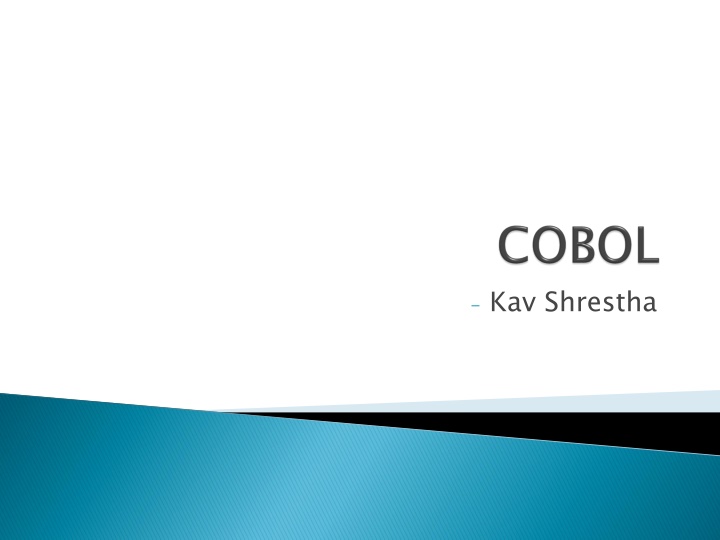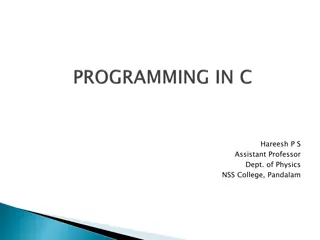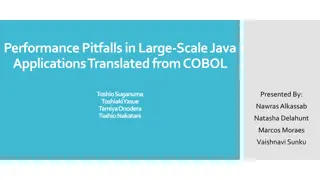
Understanding COBOL: History, Features, and Usage
"Learn about COBOL, a third-generation programming language, its history, features, and usage primarily in business and administrative systems. Explore its characteristics, structure, and impact on global applications."
Download Presentation

Please find below an Image/Link to download the presentation.
The content on the website is provided AS IS for your information and personal use only. It may not be sold, licensed, or shared on other websites without obtaining consent from the author. If you encounter any issues during the download, it is possible that the publisher has removed the file from their server.
You are allowed to download the files provided on this website for personal or commercial use, subject to the condition that they are used lawfully. All files are the property of their respective owners.
The content on the website is provided AS IS for your information and personal use only. It may not be sold, licensed, or shared on other websites without obtaining consent from the author.
E N D
Presentation Transcript
Introduction History Features COBOL Usage Characteristics Structure of COBOL Programs COBOL Divisions Data Items Variable Declaration Selection in COBOL Iteration in COBOL Object Oriented COBOL 2
Acronym for Common Business Oriented Language Third Generation programming language and one of the oldest programming language still in use Used primarily in business, finance and administrative systems for companies and governments COBOL is designed for developing business, typically file-oriented applications Not designed for writing system programs 3
Initially created in 1959 by The Short Range Committee Developed also in 1959 by the a group called Conference on Data Systems Languages (CODASYL) COBOL was one of the earliest high-level programming language The first produced version of COBOL was COBOL 60 Since then different versions such as COBOL-68, 74, 85 including COBOL 2002 have been produced 4
The original version of COBOL did not support local variables, recursion, dynamic memory allocation or structured programming constructs COBOL applications are often very large. Many COBOL applications consist of more than 1 million lines of code COBOL applications are very long lived as it cannot be simply discarded when some new programming language or technology appears 5
COBOL programs dominated the year 2000 problem. 12 million COBOL applications vs 375,000 C and C++ applications in the US alone. The reason was that when programmers were writing COBOL applications 20 years ago, they didn t anticipate it lasting into the new millennium 6
COBOL programs are used globally in military and government agencies In 1997, the Gartner Group ( an information and technology research and advisory firm) reported that 80% of the world s business ran on COBOL with over 200 billion lines of code in existence and an estimated 5 billion new lines of code each year The Gartner Group estimated for 2002 that there were about two million COBOL programmers world-wide compared to one million Java and C++ programmers each Over 95% of finance-insurance data is processed with COBOL. In 2006, IBM announced a $100 million Mainframe Simplification program as a means to shorten deployment cycles for its System z mainframes and help developers with diverse technical backgrounds deal with COBOL 7
One of the design goals for COBOL was to make it possible for non-programmers such as supervisors, managers, etc to read and understand COBOL code. COBOL contains English like structural elements as verbs, clauses, sentences, sections, etc. COBOL is a simple language with no pointers, no user defined functions. Cobol is well suited to its targeted problem domain of business computing 8
COBOL programs are hierarchical in structure Hierarchy consists of DIVISIONS, SECTIONS, PARAGRAPHS, SENTENCES and STATEMENTS * * * * * * SECTION Example: SelectUnpaidBills SECTION. FILE SECTION. SelectUnpaidBills SECTION. user defined name FILE SECTION. defined by language 9
PARAGRAPH Example: PrintFinalTotals. PROGRAM PrintFinalTotals. user defined name PROGRAM- -ID. ID. - - defined by language. SENTENCE Example: MOVE .21 TO VatRate MOVE 1235.76 TO ProductCost COMPUTE VatAmount = ProductCost * VatRate. MOVE .21 TO VatRate MOVE 1235.76 TO ProductCost COMPUTE VatAmount = ProductCost * VatRate. STATEMENT Example: SUBTRACT Tax FROM GrossPay GIVING NetPay A Statement consists of a COBOL verb (SUBTRACT) SUBTRACT Tax FROM GrossPay GIVING NetPay 10
At the top of the COBOL hierarchy are four divisions: IDENTIFICATION DIVISON: contains program information ENVIRONMENT DIVISION: contains environment information DATA DIVISION: contains data descriptions PROCEDURE DIVISION: contains the program algorithms 11
The ENVIRONMENT DIVISION is used to describe the environment in which the program will run The purpose of the ENVIRONMENT DIVISION is to isolate in one place all aspects of the program that are dependant upon a specific computer, device or encoding sequence The idea behind this is to make it easy to change the program when it has to run on a different computer or one with different peripheral devices 12
ENVIRONMENT DIVISION. CONFIGURATION SECTION. SOURCE-COMPUTER. IBM-PC. OBJECT-COMPUTER. IBM-PC. INPUT-OUTPUT SECTION. FILE-CONTROL. SELECT StudentFile ASSIGN TO "STUDENTS.DAT" ORGANIZATION IS LINE SEQUENTIAL. DATA DIVISION. FILE SECTION. FD StudentFile. 01 StudentRec. 02 StudentId PIC 9(7). 02 StudentName. 03 Surname PIC X(8). 03 Initials PIC XX. 13
3 Data Items: Variables: named location in memory into which the program can put and retrieve data Literals: data items that consist of only the data-item value itself Figurative constants: constants which when assigned to a data-item fills the whole item overwriting everything in it. Examples: ZEROS, SPACES, etc. Variable Data Types: Numeric Alphanumeric (text/string) Alphabetic 14
Variable Declaration consists of a line in the DATA DIVISION that contains the following: A level number. A data name or identifier A Picture clause Example: 01 StudentDetails. 02 StudentId PIC 9(7). 02 StudentName. 02 DateOfBirth. 02 CourseCode PIC X(4). 03 FirstName PIC X(10). 03 MiddleInitial PIC X. 03 Surname PIC X(15). 03 DayOfBirth PIC 99. 03 MonthOfBirth PIC 99. 03 YearOfBirth PIC 9(4). 15
IDENTIFICATION DIVISION. PROGRAM-ID. AUTHOR. HELLOWORLD. KAV SHRESTHA. ENVIRONMENT DIVISION. DATA DIVISION. PROCEDURE DIVISION. DISPLAY "Hello, World!" 16
IDENTIFICATION DIVISION. PROGRAM-ID. SequenceProgram. AUTHOR. KAV SHRESTHA. ENVIRONMENT DIVISION. DATA DIVISION. WORKING-STORAGE SECTION. 01 Num1 PIC 9 VALUE ZEROS. 01 Num2 PIC 9 VALUE ZEROS. 01 Result PIC 99 VALUE ZEROS. PROCEDURE DIVISION. CalculateResult. ACCEPT Num1. ACCEPT Num2. MULTIPLY Num1 BY Num2 GIVING Result. DISPLAY "Result is = ", Result. STOP RUN. 17
Selection using IF: DATA DIVISION. WORKING-STORAGE SECTION. 01 Num1 PIC 9 VALUE ZEROS. 01 Num2 PIC 9 VALUE ZEROS. 01 Operator PIC X VALUE SPACE. 01 Result PIC 99 VALUE ZEROS. PROCEDURE DIVISION. CalculateResult. ACCEPT Num1. ACCEPT Num2. ACCEPT Operator IF Operator = + THEN END-IF IF Operator = * THEN END-IF. MULTIPLY Num1 BY Num2 GIVING Result. DISPLAY "Result is = ", Result. STOP RUN. ADD Num1, Num2 GIVING Result MULTIPLY Num1 BY Num2 GIVING Result 18
QtyOfBooks QtyOfBooks ValueOfPurchases (VOP) $0-500 $0-500 $0-500 $501-2000 $501-2000 $501-2000 ValueOfPurchases (VOP) ClubMember ClubMember % Discount % Discount 1-5 6-16 >16 1-5 6-16 >16 Y Y Y Y Y Y 2% 3% 5% 7% 12% 18% EVALUATE Qty ALSO TRUE ALSO Member WHEN 1 THRU 5 ALSO VOP < 501 ALSO "Y" MOVE 2 TO Discount WHEN 6 THRU 16 ALSO VOP < 501 ALSO "Y" MOVE 3 TO Discount WHEN 17 THRU 99 ALSO VOP < 501 ALSO "Y" MOVE 5 TO Discount WHEN 1 THRU 5 ALSO VOP < 2001 ALSO "Y" MOVE 7 TO Discount WHEN 6 THRU 16 ALSO VOP < 2001 ALSO "Y" MOVE 12 TO Discount WHEN 17 THRU 99 ALSO VOP < 2001 ALSO "Y" MOVE 18 TO Discount 19
IDENTIFICATION DIVISION. PROGRAM-ID. IterationProgram. AUTHOR. KAV SHRESTHA. ENVIRONMENT DIVISION. DATA DIVISION. WORKING-STORAGE SECTION. 01 Num1 PIC 9 VALUE ZEROS. 01 Num2 PIC 9 VALUE ZEROS. 01 Result PIC 99 VALUE ZEROS. PROCEDURE DIVISION. CalculateResult. PERFORM 5 TIMES ACCEPT Num1 ACCEPT Num2 MULTIPLY Num1 BY Num2 GIVING Result DISPLAY "Result is = ", Result END-PERFORM. STOP RUN. 20
COBOL used to be a simple language with limited scope of function but Object Oriented COBOL includes new features: User Defined Functions Object Orientation Multiple Currency Symbols Dynamic Memory Allocation (pointers) Binary and Floating Point Data Types User Defined Data Types 21
IDENTIFICATION DIVISION Instead of a PROGRAM-ID, a class definition has a CLASS-ID, followed by the name of the class: CLASS-ID. Foobar INHERITS SOMObject. ENVIRONMENT DIVISION In the CONFIGURATION section, a special REPOSITORY paragraph must declare each of the base classes and any other classes used by the methods. Optionally, it may also declare the class being defined: REPOSITORY. CLASS SOMObject IS 'SOMObject' CLASS Foobar IS 'Foobar' PROCEDURE DIVISION The PROCEDURE DIVISION consists entirely of method definitions, one after another. IDENTIFICATION DIVISION ENVIRONMENT DIVISION CLASS Barfoo IS 'Barfoo PROCEDURE DIVISION 22
www.wikipedia.org The University of Limerick Computer Science and Information Systems website: http://www.csis.ul.ie/cobol/Course/Default.htm http://www.kimsoft.com/api- cobol/mis210l1a.htm 23




